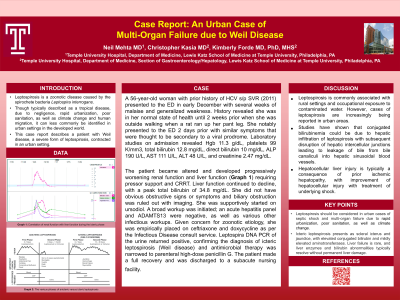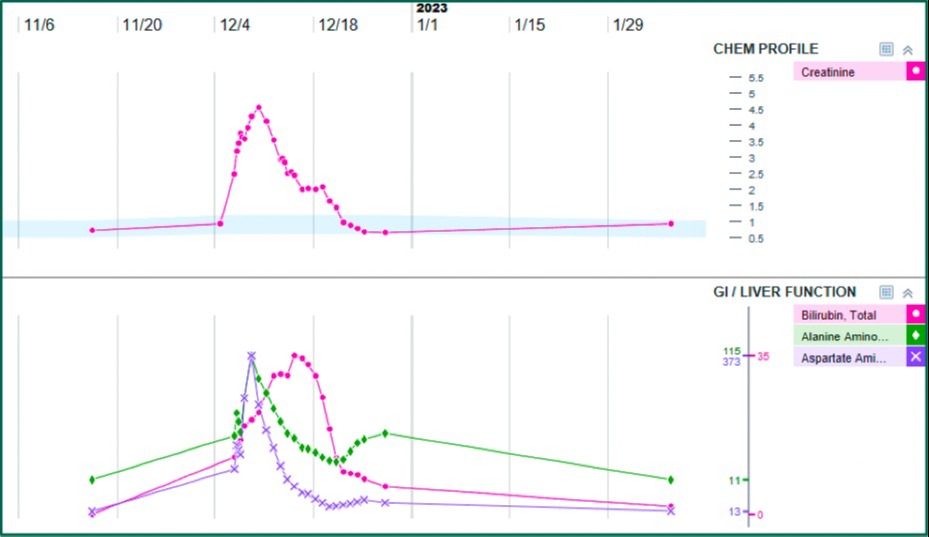Tuesday Poster Session
Category: Liver
P3905 - Case Report: An Urban Case of Multi-Organ Failure Due to Weil Disease
Tuesday, October 24, 2023
10:30 AM - 4:00 PM PT
Location: Exhibit Hall

Has Audio

Neil Mehta, MD
Temple University Hospital
Philadelphia, PA
Presenting Author(s)
Neil Mehta, MD, Christopher Kasia, MD, Kimberly Forde, MD, PhD, MHS
Temple University Hospital, Philadelphia, PA
Introduction: Leptospirosis is a zoonotic disease caused by the spirochete bacteria Leptospira interrogans. Though typically described as a tropical disease, due to negligence, rapid urbanization, poor sanitation, as well as climate change and human migration, it can less commonly be identified in urban settings in the developed world. This case report describes a patient with Weil disease, a severe form of leptospirosis, contracted in Philadelphia, USA.
Case Description/Methods: A 56-year-old woman with prior history of HCV s/p SVR (2011) presented to the ED in early December with several weeks of malaise and generalized weakness. History revealed she was in her normal state of health until 2 weeks prior when she was outside walking when a rat ran up her pant leg. She notably presented to the ED 2 days prior with similar symptoms that were thought to be secondary to a viral prodrome. Laboratory studies on admission revealed Hgb 11.3 g/dL, platelets 99 K/mm3, total bilirubin 12.8 mg/dL, direct bilirubin 10 mg/dL, ALP 190 U/L, AST 111 U/L, ALT 48 U/L, and creatinine 2.47 mg/dL. The patient became altered and developed progressively worsening renal function and liver function (Graph 1) requiring pressor support and CRRT. Liver function continued to decline, with a peak total bilirubin of 34.8 mg/dL. She did not have obvious obstructive signs or symptoms and biliary obstruction was ruled out with imaging. She was supportively started on ursodiol. A broad workup was initiated; an acute hepatitis panel and ADAMTS13 were negative, as well as various other infectious workups. Given concern for zoonotic etiology, she was empirically placed on ceftriaxone and doxycycline as per the Infectious Disease consult service. Leptospira DNA PCR of the urine returned positive, confirming the diagnosis of icteric leptospirosis (Weil's disease) and antimicrobial therapy was narrowed to parenteral high-dose penicillin G. The patient made a full recovery and was discharged to a subacute nursing facility.
Discussion: Leptospirosis is commonly associated with rural settings and occupational exposure to contaminated water. However, cases of leptospirosis are increasingly being reported in urban areas. This case highlights the severity of fulminant leptospirosis and the need for rapid, reliable diagnostic testing. Hepatocellular liver injury is typically a consequence of prior ischemic hepatopathy, with improvement of hepatocellular injury with treatment of underlying shock. Early recognition and treatment can improve outcomes.

Disclosures:
Neil Mehta, MD, Christopher Kasia, MD, Kimberly Forde, MD, PhD, MHS. P3905 - Case Report: An Urban Case of Multi-Organ Failure Due to Weil Disease, ACG 2023 Annual Scientific Meeting Abstracts. Vancouver, BC, Canada: American College of Gastroenterology.
Temple University Hospital, Philadelphia, PA
Introduction: Leptospirosis is a zoonotic disease caused by the spirochete bacteria Leptospira interrogans. Though typically described as a tropical disease, due to negligence, rapid urbanization, poor sanitation, as well as climate change and human migration, it can less commonly be identified in urban settings in the developed world. This case report describes a patient with Weil disease, a severe form of leptospirosis, contracted in Philadelphia, USA.
Case Description/Methods: A 56-year-old woman with prior history of HCV s/p SVR (2011) presented to the ED in early December with several weeks of malaise and generalized weakness. History revealed she was in her normal state of health until 2 weeks prior when she was outside walking when a rat ran up her pant leg. She notably presented to the ED 2 days prior with similar symptoms that were thought to be secondary to a viral prodrome. Laboratory studies on admission revealed Hgb 11.3 g/dL, platelets 99 K/mm3, total bilirubin 12.8 mg/dL, direct bilirubin 10 mg/dL, ALP 190 U/L, AST 111 U/L, ALT 48 U/L, and creatinine 2.47 mg/dL. The patient became altered and developed progressively worsening renal function and liver function (Graph 1) requiring pressor support and CRRT. Liver function continued to decline, with a peak total bilirubin of 34.8 mg/dL. She did not have obvious obstructive signs or symptoms and biliary obstruction was ruled out with imaging. She was supportively started on ursodiol. A broad workup was initiated; an acute hepatitis panel and ADAMTS13 were negative, as well as various other infectious workups. Given concern for zoonotic etiology, she was empirically placed on ceftriaxone and doxycycline as per the Infectious Disease consult service. Leptospira DNA PCR of the urine returned positive, confirming the diagnosis of icteric leptospirosis (Weil's disease) and antimicrobial therapy was narrowed to parenteral high-dose penicillin G. The patient made a full recovery and was discharged to a subacute nursing facility.
Discussion: Leptospirosis is commonly associated with rural settings and occupational exposure to contaminated water. However, cases of leptospirosis are increasingly being reported in urban areas. This case highlights the severity of fulminant leptospirosis and the need for rapid, reliable diagnostic testing. Hepatocellular liver injury is typically a consequence of prior ischemic hepatopathy, with improvement of hepatocellular injury with treatment of underlying shock. Early recognition and treatment can improve outcomes.

Figure: Graph 1: This graph shows the trend of this patient's renal failure with concomitant liver dysfunction, and the gradual improvement in kidney and liver function following supportive continuous renal replacement therapy
Disclosures:
Neil Mehta indicated no relevant financial relationships.
Christopher Kasia indicated no relevant financial relationships.
Kimberly Forde indicated no relevant financial relationships.
Neil Mehta, MD, Christopher Kasia, MD, Kimberly Forde, MD, PhD, MHS. P3905 - Case Report: An Urban Case of Multi-Organ Failure Due to Weil Disease, ACG 2023 Annual Scientific Meeting Abstracts. Vancouver, BC, Canada: American College of Gastroenterology.
